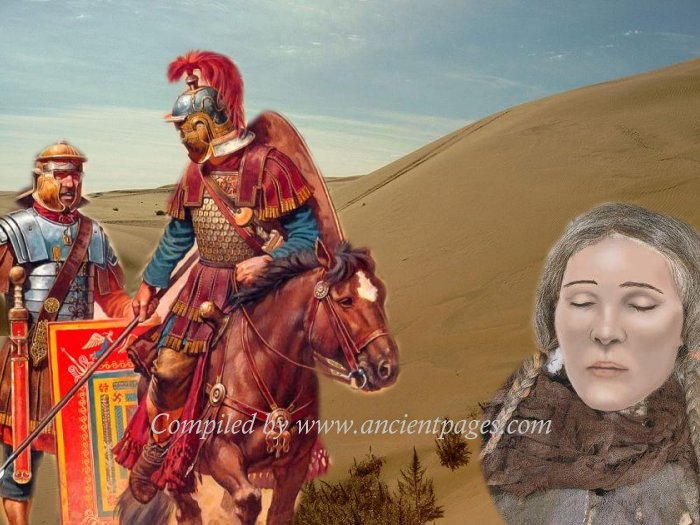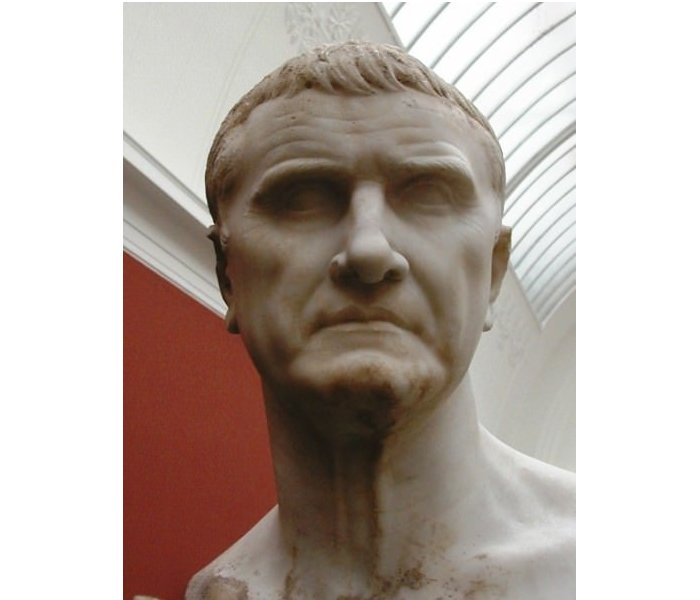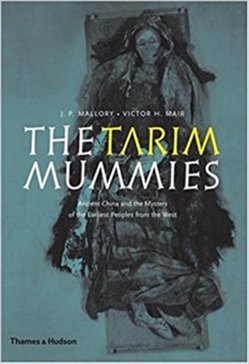Mysterious White Chinese May Be Related To Ancient Roman Soldiers – Did Marcus Crassus’ Army Settle Down In The Gobi Desert?
Ellen Lloyd - AncientPages.com - On the edge of the Gobi Desert in China, there is a fascinating group of people who are entirely different from other Chinese.
Known as the White Chinese, these people have blue or green eyes, and many are blonde. How did their ancestors end up in China? Where did they come from?
An interesting theory suggests the White Chinese may be related to ancient Romans who settled in the area a long time ago.
Evidence that supports this theory comes from DNA tests and ancient Chinese texts.
Ancient White Chinese And Their Connection To Roman General Marcus Crassus
When scientists learned about the White Chinese, they became curious and decided to learn more about how and when the ancestors of these people reached China.
DNA tests on some of the White Chinese who live in the village of Liqian, on the outskirts of the Gobi Desert, showed these people are 56% Caucasian. They have European blood, and there is reason to think they are related to ancient Romans.
Marcus Licinius Crassus (c. 115 B.C. —53 BC.) Diagram Lajard - Public Domain
In the 1950s, Homer Dubs, a professor at Oxford University, presented his theory stating that after the Battle of Carrhae in 53 B.C. between an army led by Marcus Crassus, a Roman general, and a more significant force of Parthians, the Roman Empire's eastwards expansion came to an abrupt halt.
Like their neighbors, the Scythians often succeeded in battle due to their use of horse archers. Roman-Parthian wars lasted long because the Parthians were hard to defeat.
Marcus Licinius Crassus (c. 115 B.C. —53 BC.) used Syria as the launchpad for a military campaign against the Parthian Empire, Rome's long-time Eastern enemy.
The Parthian people had established an empire that lasted almost 500 years, from the mid-3rd century BC until 224 CE. Their kingdom was the most lasting of all of the ancient Near East. Crassus' military campaign was a disastrous failure, resulting in his defeat and death at the Battle of Carrhae.
The Battle of Carrhae cost the lives of thousands of Roman soldiers. Credit: Adobe Stock - Sue Colvil
Whether Crassus died fighting or committed suicide to prevent being captured is unknown. The rumor about "dying from drinking molten gold" can be traced to historian Cassius Dio, who wrote that having discovered his body, the enemy "poured molten gold into his mouth in mockery for he had set great store by money."
When Romans lost the Battle of Carrhae, some legionaries were said to have escaped the fighting and marched east to elude the enemy. They supposedly fought as mercenaries in a war between the Huns and the Chinese in 36 B.C. In ancient Chinese texts, there are accounts of capturing a "fish-scale formation" of troops, a possible reference to the "tortoise" phalanx formation perfected by legionaries.
Historians think the wandering Roman soldiers were eventually released and settled on the steppes of western China. Some experts dismiss the Chinese-Roman connection and suggest the White Chinese descended from the armies of Huns that marauded through central Asia, which included soldiers of Caucasian origin.
Archaeological Evidence Ancient Romans Visited And Stayed In China?
If the Chinese were in contact with ancient Roman soldiers who decided to stay in the Gobi Desert, there should be some archaeological evidence. We should be able to find ancient Roman forts or other structures and artifacts of Roman origin. Archaeologists are excavating in the area, looking for clues and solid evidence that can shed more light on this ancient mystery.
Victor H. Mair - The Tarim Mummies: Ancient China and the Mystery of the Earliest - read more
So far, scientists have not discovered any ancient Roman artifacts in the region.
Still, other findings clearly show white people from Europe were present in the Gobi Desert and neighboring areas.
Beauty Of Loulan And The Tarim Mummies Of China
One of the most striking archaeological findings was the discovery of a Northern European tribe in the northeast corner of Xinjiang province, near the Celestial Mountains and the Takla Makan Desert on the edge of the Gobi Desert. There is a whole ancient world buried under the vast Taklamakan Desert, and archaeologists are beginning to discover some of the secrets that have been hidden in this mysterious region.
In 1900, Swedish archaeologist Sven Hedin discovered ruins of the ancient city Loulan, buried under the sand.
In 1910, ten years after Loulan was found, a local hunter discovered a tomb near a creek 175 kilometers away from Loulan.
Cai Junnian lives in Liqian. His green eyes give a hint he may be a descendant of Roman mercenaries who allegedly fought the Han Chinese 2,000 years ago Photo: Natalie Behring
It was named the "creek tomb." It was built using more than 100 wooden poles erected on a dune. The tomb is considered one of the most intriguing mysteries of ancient Asian civilization. Chinese experts say it belongs to the early Bronze Age, whose history in Xinjiang stretches back to 4,000 years ago.
Half a century later, in 1979, a female corpse dating back nearly 4,000 years was discovered in Loulan. The corpse was well preserved and nicknamed the "Beauty of Loulan."
At a place called Qizilchoqa, or, as the local people called it, Red Hill, researchers found a grave with unusual mummies that were still well-preserved.
The mummies were never embalmed. Ancient people placed the corpses on the ground, and the dead bodies were subjected to a unique weather system - heat, aridity, and bitter winter cold mixed with salty soil.

The mummy was nicknamed the "Beauty of Loulan". To the right is her face as reconstructed by an artist.
They were in such good condition that their clothes were in excellent condition.
As many as 113 mummies were recovered at the site. Examinations revealed these people had blonde hair, big eyes, and European noses. They became known as the Tarim mummies.
These people were once members of an advanced ancient civilization. The women had artificial extensions in their hair, and scars on their bodies showed they had rudimentary operating skills.
In 1993, Italian genetics examined the bodies and could confirm these people were from the Bronze Age, they were Caucasian, and it is possible that they interacted with the indigenous people at that time. The Tarim mummies are about 4,000 years old, and the youngest at about 2,000.
4,000-year-old Tarim mummies. Credit: Wikimedia Commons
An artist's impression of what this mummy possibly looked like when alive. Credit: Fair Use
The true identity of the Tarim race is unknown, but historians and archaeologists think these remarkable people were probably Scandinavian or German. Why they came to China 4,000 years ago is a mystery, but they likely interacted with the Chinese.
So, the White Chinese living on the edge of the Gobi Desert may have ancestors from Scandinavia or Germany. The theory that ancient Roman soldiers settled in the region is naturally intriguing but needs to be backed up by archaeological evidence.
Updated on November 8, 2023
Written by - Ellen Lloyd – AncientPages.com
Copyright © AncientPages.com All rights reserved. This material may not be published, broadcast, rewritten or redistributed in whole or part without the express written permission of AncientPages.com
Expand for referencesMore From Ancient Pages
-
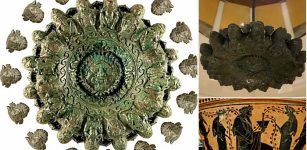 Etruscan Beautiful Bronze Lamp of Cortona – Studied
Artifacts | Apr 10, 2024
Etruscan Beautiful Bronze Lamp of Cortona – Studied
Artifacts | Apr 10, 2024 -
 3.2 Million-Year-Old ‘Lucy’ Could Walk On Two Legs – First Hominin Muscle Reconstruction
Archaeology | Jun 20, 2023
3.2 Million-Year-Old ‘Lucy’ Could Walk On Two Legs – First Hominin Muscle Reconstruction
Archaeology | Jun 20, 2023 -
 How Did Vikings Worship Their Gods?
Ancient History Facts | May 25, 2016
How Did Vikings Worship Their Gods?
Ancient History Facts | May 25, 2016 -
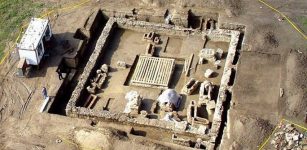 Viminacium Ancient Roman Camp: Sarcophagus With Skeletons, Rich Grave Goods Found In Serbia
Archaeology | Jun 5, 2018
Viminacium Ancient Roman Camp: Sarcophagus With Skeletons, Rich Grave Goods Found In Serbia
Archaeology | Jun 5, 2018 -
 Land of Israel: A 5,000-Year-Old Settlement And A Pottery Kiln Unearthed Near Beit Shemesh At The Site Of Hurvat Husham
Archaeology | Oct 30, 2024
Land of Israel: A 5,000-Year-Old Settlement And A Pottery Kiln Unearthed Near Beit Shemesh At The Site Of Hurvat Husham
Archaeology | Oct 30, 2024 -
 Caligula: The Sole Roman Emperor Associated With The Plant Hellebore And The Ancient Greek Town Of Antikyra
Archaeology | Jul 11, 2025
Caligula: The Sole Roman Emperor Associated With The Plant Hellebore And The Ancient Greek Town Of Antikyra
Archaeology | Jul 11, 2025 -
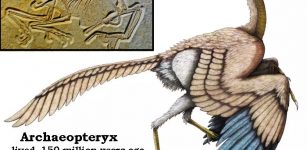 Oldest Recently Discovered Fossil of Bird ‘Archaeopteryx’ That Lived 150 Million Years Ago
Archaeology | Jan 29, 2018
Oldest Recently Discovered Fossil of Bird ‘Archaeopteryx’ That Lived 150 Million Years Ago
Archaeology | Jan 29, 2018 -
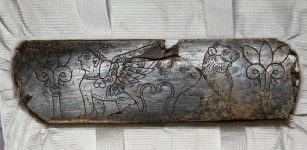 Unique 2,800-Year-Old Ivory Object Unearthed At Hattusa
Archaeology | Nov 14, 2023
Unique 2,800-Year-Old Ivory Object Unearthed At Hattusa
Archaeology | Nov 14, 2023 -
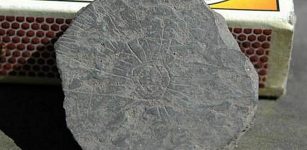 More Than 300 ‘Sun Stones’ Dated To Stone Age Discovered On Danish Island Of Bornholm
Archaeology | Dec 20, 2017
More Than 300 ‘Sun Stones’ Dated To Stone Age Discovered On Danish Island Of Bornholm
Archaeology | Dec 20, 2017 -
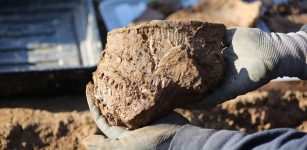 Bronze Age Finding Offer New Clues On The Beginnings Of Cardiff
Archaeology | Jul 15, 2022
Bronze Age Finding Offer New Clues On The Beginnings Of Cardiff
Archaeology | Jul 15, 2022 -
 Oldest Cyrillic Inscriptions Dated To The Time Of King Simeon the Great – Discovered
Archaeology | May 3, 2023
Oldest Cyrillic Inscriptions Dated To The Time Of King Simeon the Great – Discovered
Archaeology | May 3, 2023 -
 Norse Watcher Spirit Vörðr Followed A Person From Birth To Death
Featured Stories | Dec 6, 2017
Norse Watcher Spirit Vörðr Followed A Person From Birth To Death
Featured Stories | Dec 6, 2017 -
 How Did A Piece Of An ‘Epic’ Viking Sword End Up In The Netherlands?
Vikings | Dec 4, 2024
How Did A Piece Of An ‘Epic’ Viking Sword End Up In The Netherlands?
Vikings | Dec 4, 2024 -
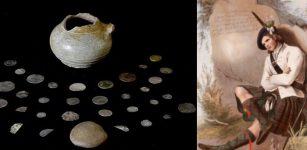 Coin Hoard Paints A Fascinating Picture Of Life Of Highland Clan Chief And His Household
Archaeology | Oct 13, 2023
Coin Hoard Paints A Fascinating Picture Of Life Of Highland Clan Chief And His Household
Archaeology | Oct 13, 2023 -
 900-Year-Old Crypt At Old Dongola: Magical Inscriptions And Mysterious Signs Found
Archaeology | Sep 12, 2015
900-Year-Old Crypt At Old Dongola: Magical Inscriptions And Mysterious Signs Found
Archaeology | Sep 12, 2015 -
 Surprising Discovery Of Ancient Roman Salt Factory In England
Archaeology | Oct 8, 2020
Surprising Discovery Of Ancient Roman Salt Factory In England
Archaeology | Oct 8, 2020 -
 Mysterious Ancient Inscriptions Never Meant To Be Read – Biblical Secrets Revealed
Ancient Mysteries | May 17, 2018
Mysterious Ancient Inscriptions Never Meant To Be Read – Biblical Secrets Revealed
Ancient Mysteries | May 17, 2018 -
 What Is A Mural Of Tepoztēcatl, Aztec Rabbit God Of Alcohol Doing In A Mexican Church?
Archaeology | Oct 15, 2022
What Is A Mural Of Tepoztēcatl, Aztec Rabbit God Of Alcohol Doing In A Mexican Church?
Archaeology | Oct 15, 2022 -
 Mysterious People Who Appeared Out Of Nowhere
Featured Stories | Sep 1, 2018
Mysterious People Who Appeared Out Of Nowhere
Featured Stories | Sep 1, 2018 -
 Oldest Human Made Architectural Plans Detail Mysterious Desert Megastructures
Archaeology | May 18, 2023
Oldest Human Made Architectural Plans Detail Mysterious Desert Megastructures
Archaeology | May 18, 2023

